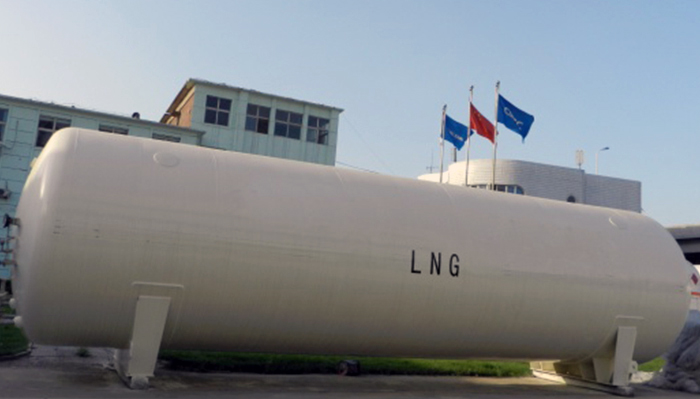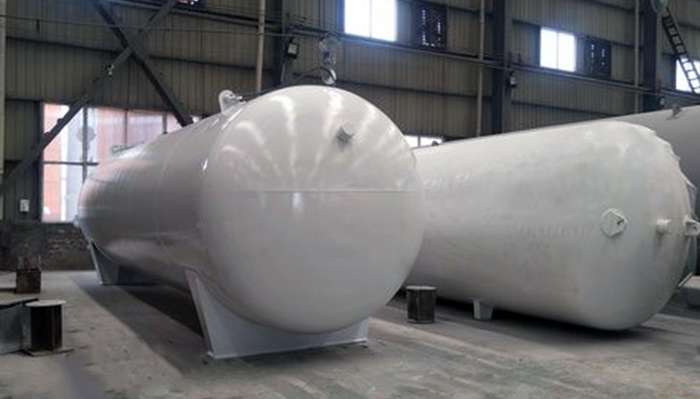Product Category
Special requirements for LNG cryogenic storage tanks
Date: Apr 23, 2020

Natural gas is recognized as a clean, environmentally friendly, and safe high-quality energy source. The volume of liquefied natural gas is reduced by about 600 times, which brings great benefits to storage. Atmospheric cryogenic storage tanks are used for storing liquefied natural gas.LNG tanks have the following four special requirements.
1. Low temperature resistance; the boiling point of LNG under normal pressure is -160 ℃. Choose the low-temperature and normal-pressure storage method to reduce the temperature of the natural gas below the boiling point, so that the operating pressure of the normal-pressure low-temperature storage tank is slightly higher than normal pressure. Compared with the high-pressure and normal-temperature storage method, it can greatly reduce the thickness of the tank wall and improve safety performance; Therefore, the atmospheric low temperature storage tank is required to have good low temperature resistance and excellent cold retention performance.
2. High safety requirements; due to the cryogenic liquid stored in the tank, once an accident occurs in the storage tank, the refrigerated liquid will evaporate a lot, and the amount of vaporization is about 300 times that of the original refrigerated state, forming an air mass that will automatically detonate in the atmosphere . Therefore, API, BS and other specifications require the cryogenic storage tank to adopt a double-wall structure, using the blocking concept. When the first layer of tank leaks, the second layer of tank can completely block the leaked liquid and evaporated gas Safe to store. 3. Special materials; the inner tank wall of LNG storage tank requires low temperature resistance, generally 9Ni steel or aluminum alloy and other materials are used, and the outer tank wall is prestressed reinforced concrete.
3. Special materials; the inner tank wall of LNG storage tank requires low temperature resistance, generally 9Ni steel or aluminum alloy and other materials are used, and the outer tank wall is prestressed reinforced concrete.
4. Tumbling phenomenon; Tumbling phenomenon refers to the phenomenon that two layers of LNG with different densities are quickly turned upside down in a low-temperature storage tank to mix, and a large amount of gasification occurs instantly. At this time, the vaporization amount of LNG in the tank is 10 to 50 times the normal natural evaporation, which will cause the air pressure in the storage tank to rise rapidly and exceed the set safety pressure, causing the storage tank to appear overpressure. If it is not discharged through the safety valve in time, it may cause mechanical damage to the storage tank, causing economic losses and environmental pollution. The root cause of the tumbling phenomenon is that the liquid density of different layers in the storage tank is different, and the existence of stratification has an important effect on the time and severity of evaporation and tumbling.
1. Low temperature resistance; the boiling point of LNG under normal pressure is -160 ℃. Choose the low-temperature and normal-pressure storage method to reduce the temperature of the natural gas below the boiling point, so that the operating pressure of the normal-pressure low-temperature storage tank is slightly higher than normal pressure. Compared with the high-pressure and normal-temperature storage method, it can greatly reduce the thickness of the tank wall and improve safety performance; Therefore, the atmospheric low temperature storage tank is required to have good low temperature resistance and excellent cold retention performance.
2. High safety requirements; due to the cryogenic liquid stored in the tank, once an accident occurs in the storage tank, the refrigerated liquid will evaporate a lot, and the amount of vaporization is about 300 times that of the original refrigerated state, forming an air mass that will automatically detonate in the atmosphere . Therefore, API, BS and other specifications require the cryogenic storage tank to adopt a double-wall structure, using the blocking concept. When the first layer of tank leaks, the second layer of tank can completely block the leaked liquid and evaporated gas Safe to store.

4. Tumbling phenomenon; Tumbling phenomenon refers to the phenomenon that two layers of LNG with different densities are quickly turned upside down in a low-temperature storage tank to mix, and a large amount of gasification occurs instantly. At this time, the vaporization amount of LNG in the tank is 10 to 50 times the normal natural evaporation, which will cause the air pressure in the storage tank to rise rapidly and exceed the set safety pressure, causing the storage tank to appear overpressure. If it is not discharged through the safety valve in time, it may cause mechanical damage to the storage tank, causing economic losses and environmental pollution. The root cause of the tumbling phenomenon is that the liquid density of different layers in the storage tank is different, and the existence of stratification has an important effect on the time and severity of evaporation and tumbling.
Last article:
Next article:
Send Your Inquiry
We not only provide a good product, but also provide high quality service. If you are interested in our products,
you can contact us in the following ways.
you can contact us in the following ways.















































































































